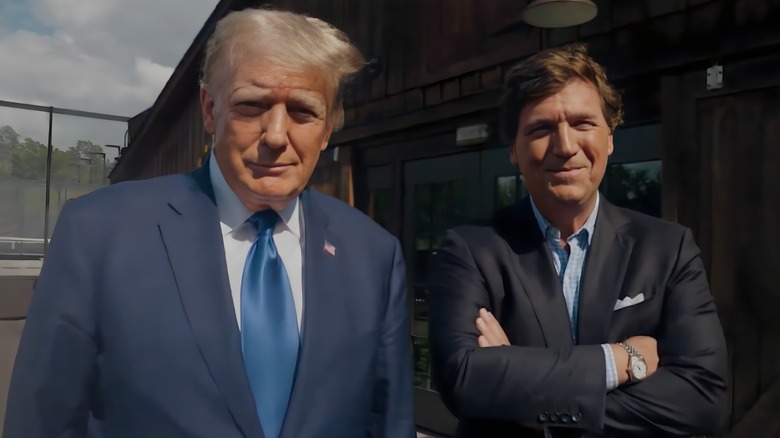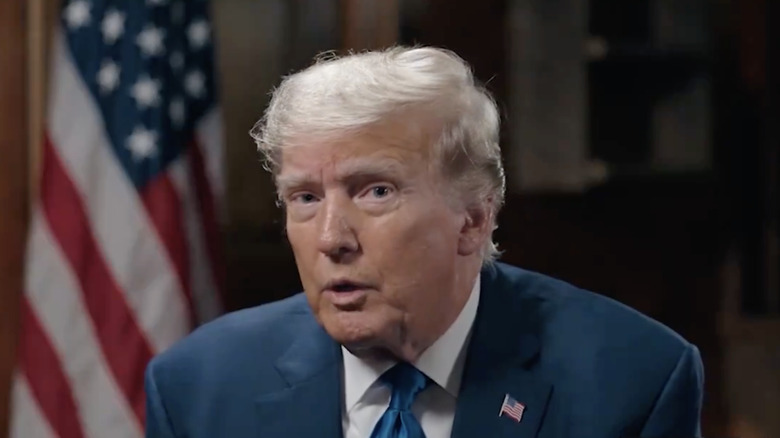Expert Tells Us Trump's Body Language Shows His True Motivation Behind GOP Debate Absence
The first Republican presidential primary debate in the lead-up to the 2024 election is now in the history books. Eight presidential hopefuls took the stage in Wisconsin and things got heated. At one point, Chris Christie called out Vivek Ramaswamy for ripping off a Barack Obama quote. Former governor of South Carolina Nikki Haley got audience applause when she attacked Ramaswamy for his lack of foreign policy experience. And Ron DeSantis got called out by viewers at home for his forced smile.
But for all the back and forth between candidates on the stage, there was one person whose absence was notable — Donald Trump. Bret Baier, one of the Fox News moderators for the debate, referred to Trump as "the elephant not in the room" (via USA Today). Trump notably skipped the debate and instead pre-recorded an interview with former Fox News host Tucker Carlson that was posted on Twitter five minutes before the debate began. And the first question from Carlson was about why Trump wasn't at the debate.
The List spoke with Mark Bowden, a renowned body language expert, royal commentator, and co-founder of TRUTHPLANE about what we could learn from Trump's body language as he explained why he really wasn't at the debate. Bowden thinks that based on Trump's body language, Trump feels it was "a moral obligation not to attend."
Donald Trump's body language showed what was important to him
Donald Trump told Tucker Carlson in their Twitter interview that he didn't think it would have been worth it for him to go to the debate considering how Fox News has treated him and the fact that his poll numbers have him as the clear front-runner. He didn't see the debate as worth his time.
Body language expert Mark Bowden told The List that Trump's shrugging during his response indicated his true feelings. "Single shoulder shrugs are often associated with uncertainty, while a double shrug signifies matter-of-factness," he said. "On the question of why he is not at the debates, he is consistent in his use of the double shrug." Bowden noted that Trump used the double shrug to reinforce a popular part of his platform, doing it when he said, "When I was winning." Bowden explained, "Winning is part of his brand promise, so the double shrug conveys that winning is considered a default for him." Perhaps most telling was Trump's double shrug when he said, "I don't think it's right to do it." Bowden said Trump's double shrug here "reinforces that he wants us to understand it's more of a moral obligation not to attend."
Overall, Bowden saw Trump as portraying a sense of control over the situation, particularly in the way he sat with his "hands 'steepled,' fingers wide, and thumbs up in a signal of confidence and power."
Donald Trump worked to connect with viewers at home
Mark Bowden also broke down the meaning of Donald Trump making eye contact with the camera when speaking with Tucker Carlson. Trump often focused his gaze on Carlson as he spoke, so it was notable for Bowden when Trump would glance at the camera. Bowden said that Trump "looks down the lens for recognition and alignment from the audience on points he wants to emphasize."
And some of the points that he found worthy of emphasis included when he noted his poll numbers, first saying that he was up by 50 to 60 points and then saying one poll had him up by 70 points. "As the numbers increase," Bowden said, "he looks at the camera again to ensure that we're buying into the growing numbers."
Trump also looked at the camera when he referred to Ron DeSantis as "a lost cause." Bowden saw that as a telling moment: DeSantis "may be who he sees as his biggest competition right now, and so he gives eye contact down the camera to the audience with this discrediting phrase."

